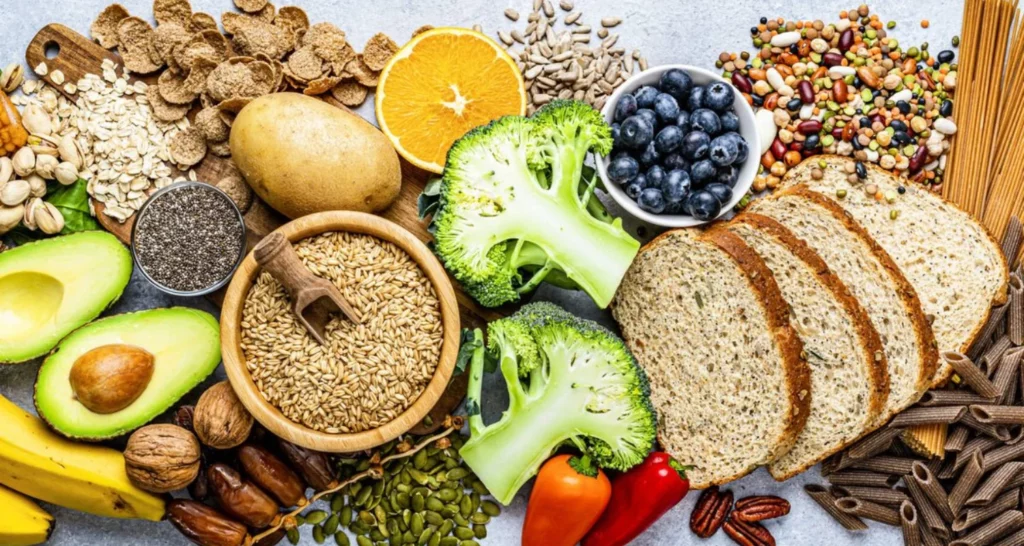Last Updated on: 13th December 2025, 05:58 am
Discover the connection between a high-fiber diet on dental health right here. Learn the top 5 benefits and why incorporating more fiber is a must for your oral care routine.
Incorporating a balanced diet and nutritious foods into your everyday life is key to promoting general health. Fiber, present in vegetables, whole grains, legumes, and fruits (like apples) offers multiple benefits for our bodies that go beyond just aiding our digestive system. In fact, incorporating a high-fiber diet can improve our oral health as well! From helping with tooth cleaning to reducing tooth decay, fiber-rich foods contribute to maintaining a healthy mouth and a pretty smile. So, let’s delve into the specific ways in which a high-fiber diet can promote oral health.
High-Fiber Diet on Dental Health
What is a High-Fiber Diet?
A high-fiber diet is characterized by an emphasis on consuming foods rich in a complex compound called fiber, an element that is essential for promoting overall well-being. Our diet has changed a lot compared to our ancestral humans, who might have consumed up to 100 grams a day, while in the US now, the average daily consumption of dietary fiber is around 17 grams a day. Studies show that people are either eating too many processed foods and fewer vegetables and fruits, or they are avoiding carbohydrate-rich foods. Either way, they are falling short of meeting the recommended daily dietary amount of fiber.
A high-fiber diet prioritizes foods high in natural fiber such as fruits, vegetables, whole grains, seeds, and nuts. Besides the rich fiber amount, these foods also provide a wide variety of vitamins, antioxidants, and minerals. The recommended daily intake from the World Health Organization for an adult includes 2 cups of fruit (4 servings), 2.5 cups of vegetables (5 servings), 180 g of grains, and 160 g of meat and beans. Some examples of high-fiber foods include berries, apples, oats, quinoa, lentils, chia seeds, leafy greens, avocados, beans, etc.
Why Does Dental Health Matter?
Your mouth is the “window” and “door” of your body. Many systemic diseases show their first signs in the oral mucosa; a detailed intraoral examination will also show signs of drug abuse or trauma. On the other hand, the mouth serves as a door for a lot of microorganisms to enter the body and cause systemic diseases.
A bidirectional relationship exists between dental and overall health. Poor oral health is linked to several chronic diseases. A study suggests a connection between periodontitis and an increased risk for diabetes and cardiovascular disease. On the other hand, many systemic diseases and mental health conditions affect oral health, causing gum inflammation and dental structure degradation.
The Top 5 Benefits of a High-Fiber Diet on Dental Health
Diet and nutrition are tightly connected to dental health. A well-balanced diet can prevent the development of different dental diseases like periodontal disease and tooth decay, and vice versa; or poor health can affect one’s ability to eat and absorb the proper nutrition. The benefits of a high-fiber diet are not limited to gut health; they also improve oral health in more ways than one. Here are the top 5 benefits of a high-fiber diet:
1. Natural teeth cleaning
Fiber-rich foods, like fruits and vegetables, help with teeth cleaning. In general, these foods have a firm texture that comes into close contact with the tooth surface as you chew. The fibrous texture gently scrubs away any food particles and removes them. Some fiber-rich foods, like carrots and celery, have stringy structures that get between your teeth and act as natural floss.
2. Stimulates saliva production
Fibrous foods can increase salivation through the processes of chewing and taste. The act of chewing itself stimulates the salivary glands, leading to increased salivary production. However, since fibrous foods require more chewing, the prolonged chewing time stimulates salivary glands even more. In addition, fiber-rich foods, especially acidic foods, trigger salivation. The increased saliva production rinses away food particles and remineralizes the enamel.
3. Reduces gum disease risk
Studies show that a low-fiber diet is linked to periodontal disease since fiber-rich foods can directly and indirectly affect our gums. They increase salivation, mechanically remove food and prevent plaque formation. They are rich in probiotics that help “good” bacteria grow. Indirectly, a high-fiber diet decreases inflammation in the body, which means that it prevents gum disease.
4. Lowers tooth decay rates
A high-fiber diet can reduce tooth decay rates by increasing saliva production, creating an alkaline environment that neutralizes acids in the mouth. A high nutrient content like calcium, vitamin D and phosphorus supports and strengthens the enamel.
5. Improves overall oral health
The benefits of a high-fiber diet on dental health are numerous. From gums to dental structure, a high-fiber diet is crucial for optimal oral health, starting from childhood.
Incorporating High-Fiber Diet on Dental Health
Incorporating high-fiber food in your diet is easy and without effort. Here’s some tips:
● For breakfast, switch from cereal to oats. Overnight oats mixed with chia seeds turn into a pudding texture. Youan add fresh fruits like a banana or apple, or dried fruits and nuts to adjust the taste to your liking.
● Eat fruits or vegetables like carrots and celery as your between-meal snacks.
● Pack a side salad with your lunch. You can include your favorite vegetables to make it tastier.
● Swap the usual white rice with brown rice, opt for whole-wheat pasta, and eat more baked potatoes with the skin left on.
Conclusion
The impact of a high-fiber diet on dental health seems to be quite significant. Not only is it good for your well-being, but it can be beneficial to your oral health routine as well. However, even though chewing an apple can clean your teeth between meals, it doesn’t mean it should substitute for your brushing routine.
Frequently Asked Questions
Can a high-fiber diet improve bad breath?
Yep, scientists have discovered something pretty cool: after comparing a low-fiber meal to a high-fiber feast, they found that the bad breath boogeyman didn’t stand a chance against the fiber-rich option. Not only did it require more chewing, but it kept the breath fresh way longer. talking about a whopping eight hours of freshness! So, next time you’re prepping a meal, go heavy on the fiber if you want to keep your breath as fresh as your dishes. Chew on that!
How does fibrous food affect your teeth?
According to the American Dental Association (ADA), fibrous foods are fantastic for maintaining clean teeth and gums. Not only do they scrub your mouth with every bite, but they also kick saliva production into high gear. This saliva surge acts as your mouth’s natural armor, second only to diligent at-home dental care, protecting against cavities and gum disease.
Do fibrous foods benefit your teeth and bones?
Absolutely. Consuming foods high in fiber can lower the risk of tooth loss by approximately 30%. Additionally, since receding gums may lead to bone deterioration, eating fiber-packed foods like bananas, leafy greens, and whole grains can decrease the likelihood of experiencing bone loss by 24%.
How does consuming high-fiber foods benefit oral health?
Eating foods high in fiber plays a crucial role in maintaining oral health by stimulating saliva flow, which is the mouth’s natural defense against cavities and gum disease. The physical action of chewing fibrous foods also helps clean the teeth and gums by removing food particles and plaque. This dual action of mechanical cleaning and increased saliva production helps to protect the mouth from dental issues, ensuring that the teeth and gums remain healthy.
Can a high-fiber diet reduce the risk of developing gum disease?
Yes, a diet rich in fiber can significantly reduce the risk of developing gum disease. Fiber-rich foods promote saliva production, which not only neutralizes harmful acids in the mouth but also washes away food particles and bacteria, the main culprits behind gum disease. Additionally, the anti-inflammatory properties of many high-fiber foods can help reduce gum inflammation, further protecting against periodontal diseases. Incorporating a variety of fiber-rich fruits, vegetables, and whole grains into your diet is a smart strategy for maintaining gum health.
Share:
References
1. BA;, N. S.-F. M. K. (2016). Dietary fiber intake is inversely associated with periodontal disease among US adults. The Journal of nutrition. https://pubmed.ncbi.nlm.nih.gov/27798338/
2. Liccardo, D., Cannavo, A., Spagnuolo, G., Ferrara, N., Cittadini, A., Rengo, C., & Rengo, G. (2019, March 20). Periodontal disease: A risk factor for diabetes and cardiovascular disease. MDPI. https://www.mdpi.com/1422-0067/20/6/1414
3. McKeown, N. M., Fahey, G. C., Slavin, J., & Kamp, J.-W. van der. (2022, July 20). Fiber intake for Optimal Health: How can healthcare professionals support people to reach dietary recommendations?. The BMJ. https://www.bmj.com/content/378/bmj-2020-054370
4. SB;, E. (n.d.). The ancestral human diet: What was it and should it be a paradigm for contemporary nutrition?. The Proceedings of the Nutrition Society. https://pubmed.ncbi.nlm.nih.gov/16441938/
5. Stephen AM;Champ MM;Cloran SJ;Fleith M;van Lieshout L;Mejborn H;Burley VJ; (n.d.). Dietary fiber in Europe: Current state of knowledge on definitions, sources, recommendations, intakes and relationships to health. Nutrition research reviews. https://pubmed.ncbi.nlm.nih.gov/28676135/
6. Touger-Decker R;Mobley C; (n.d.). Position of the Academy of Nutrition and Dietetics: Oral Health and Nutrition. Journal of the Academy of Nutrition and Dietetics. https://pubmed.ncbi.nlm.nih.gov/23601893/
7. World Health Organization. (n.d.). Healthy diet. World Health Organization. https://www.who.int/news-room/fact-sheets/detail/healthy-diet
-
Nayibe Cubillos M. [Author]
Pharmaceutical Chemestry |Pharmaceutical Process Management | Pharmaceutical Care | Pharmaceutical Services Audit | Pharmaceutical Services Process Consulting | Content Project Manager | SEO Knowledge | Content Writer | Leadership | Scrum Master
View all posts
A healthcare writer with a solid background in pharmaceutical chemistry and a thorough understanding of Colombian regulatory processes and comprehensive sector management, she has significant experience coordinating and leading multidisciplina...



















